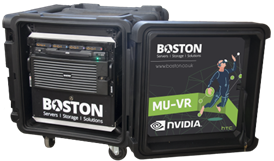Every now and again, Events for Gamers runs into a product or service that perfectly intersects both events and games. At NVIDIA’s GTC 2018, that product was from a United Kingdom-based company best known for servers. The Boston Limited Roamer MU-VR (multi-user virtual reality) is a rather cleverly named turnkey virtual reality server set-up for up to four VR users running off the server. For example, say, at a games showcase, a VR developer might want to show off a multiplayer VR game at their table, and conceivably, with the MU-VR set-up, run a multiplayer demo of their game from one server to four screens. Or, the MU-VR could be the hardware core of a VR arcade set-up. The potential uses for the MU-VR are many and intriguing, so it caught my attention from the start.
I didn’t get a hands-on with the MU-VR at GTC 2018, but I did find out a lot about the device, where it began and where the device development is headed.
The system comes packed in a ruggedized 10U shipping crate, so it can withstand the rigors of mobility. Inside the portable server, dual Xeon E5-2667 processors run the MU-VR. Four NVIDIA Quadro P6000 GPUs, 128GB DDR, with an allocation of up to 32GB per user, are designed to ensure there are enough resources to go around. Unsurprisingly, plenty of juice is needed to run this VR powerhouse, with a requirement of 3200 watts. So, for some applications, this might be more power than might be needed, in more ways than one. Helpfully, to ensure a fully turnkey setup, four HTC Vive (not Pro, at least not yet) VR headsets are included with the default MU-VR package.

The MU-VR began it’s recent life as a collaborative idea between Boston Limited and NVIDIA, at GTC Europe 2017 in October in Munich. The idea floated was about building a “production-ready multi-user VR system based on their concept,” explained Dan Johns, Head of Technical Services at Boston Limited in an email QA.
From that point, the company quickly built a prototype, then streamlined it for easier deployment and operation. HTC became a partner, whose head-mounted displays are featured as part of the MU-VR package.
Giving a sense how quickly the MU-VR went from idea to prototype to event-ready, Johns added: “The latest iteration of the MU-VR was recently showcased on the HTC stand at MWC in Barcelona, along with the game Arizona Sunshine,” utilizing (and teasing) the early version of the wireless version of the HTC Vive. Boston Limited has been further working with HTC since then to integrate wireless 5G technology, enabling wireless headsets for the freedom to roam in virtual reality.
For a device that is very likely on the spendy side (pricing is quoted by request), it will likely get compared to other devices that are less expensive while portable and VR ready, such as backpack VR computers or compact PCs. Johns explains the value proposition for the MU-VR: “Firstly, the system is easy to move from location to location in its ruggedized rack, and fast to set up. It can be done in under 30 minutes and you can have 4 users online and working in that time, with minimum complexity. The virtualized platform, too, means that managing users, software images and applications are simple using templates and clones. Patches and security updates can be rolled out quickly and easily, essential with new malware and CVE’s (common vulnerabilities and exposures) coming every day. Backpack PC’s are a nice way to get wire-free, but with the new HTC wireless headsets, we’ll be able to take away the weight, go wire-free and still give the benefits of centralized management.”
The MU-VR stands a good chance to attract some specialized attention, like event planners, VR arcade owners, party planners, venue owners, and so forth, because of the advertised ease-of-setup and creative and custom applications potential. But the device might benefit from more configurations, for developers and meeting planners with different needs.
With that in mind, Dan Johns mapped out where the development of the Roamer MU-VR is heading in the near future. They’re looking to create a solution that can host six virtual reality users, which allows for more versatility in the kinds of applications and venues where the MU-VR can be deployed. Some Boston Limited clients have requested for a non-virtualized platform on a lower-cost 1U rack appliance, for customers with smaller requirements. The wireless head-mounted VR is also on the way toward being a part of the MU-VR package.
To learn more about Boston Limited’s Roamer MU-VR kit, more info can be found at their official site.



